
Agile Planning - Build a Better Product with Iterations and Integrity!
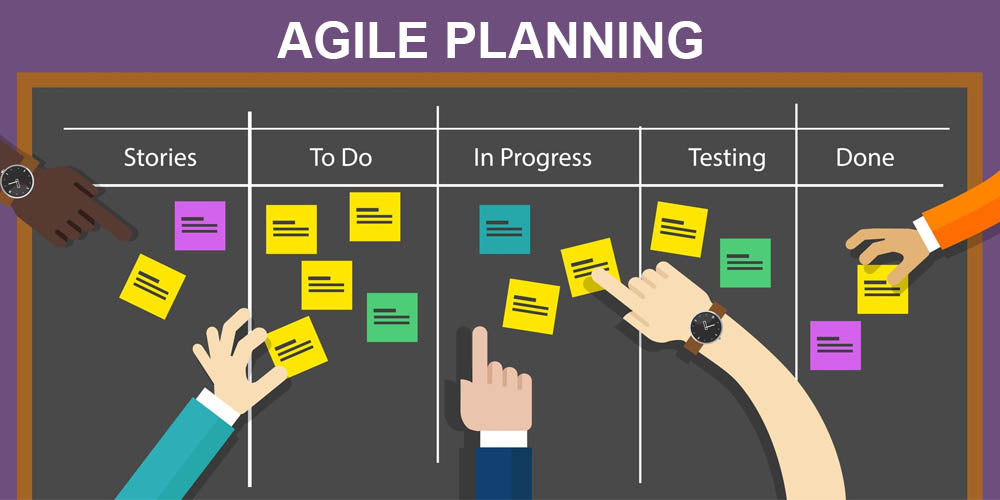
Various industries should estimate the length of their projects to save money and administer resources well. But, what is the best approach to achieve this goal and introduce an excellent product to clients and stakeholders?
The short answer is Agile Planning.
What is Agile Project Planning?
This article mentions all the aspects related to this great way of planning customer projects. This way, you'll improve the communication between you, stakeholders, and team members.
What Is Agile Project Planning?
There are different types of planning a project. Traditional ways establish each step from scratch, leaving no space for future changes; meanwhile, agile planning is the opposite.
Agile project planning is designed for change via an iterative perspective to planning. These changes are put into practice after completing a small design process and releasing the product to the users.
In other words, agile planning is flexible, prone to changes and new points of view, and continuously evolves to provide good portions of the final product or solution.
Embrace the change in project management with an Agile Planning process!
Characteristics of Agile Planning

Below we mention some main characteristics most organizations may adopt when performing an agile project planning process.
1. It’s Divided into Releases and Sprints/Iterations
Agile project management divides the plan into several stages called "releases." A release is the creation of a new product or a significant update to an existing product.
At the same time, a release is divided into several minor stages, or iterations, called "Sprints." These sprints have a determined length and a series of items to work through in each specific sprint.
2. It’s Based on User Stories/Features
As we mentioned earlier, agile projects are continuously changing based on the feedback of clients and the experience of users. So, one of the most critical project management practices here is to consider what is best for those users.
Items or articles that satisfy these users' needs are called "User Stories" or "Features."
Teams can use features to track progress, enhance some particular development, test processes, etcetera.
Agile principles say that the team only creates specifications and documents for each user's needs. During the sprint, the agile team should be capable of identifying those requirements and know how to address them to carry on the agile project plan.
This way, stakeholders can develop their tasks while managing projects in the best way possible, delivering their conclusions and resolutions.
3. It’s Iterative and Incremental
Sprints in any agile project plan must have the same length. Thus, the involved agile teams can repeat the process. This practice ensures that the entire team achieves better results and a better-finished product.
This iterative process leads to a better use of time since team members learn what to do during the sprint and how many stories they can complete. In this sense, the agile project management methodology is incremental since the knowledge is accumulated throughout the subsequent processes.
4. The Team's Members do their Estimations
In an agile plan, the development team is part of planning and estimation, not just management. Teams decide the complexity of stories during the sprint planning process. This way, the team leverages what is better for their participants.
The process of defining the complexity of the work is called Story Point.
For instance, a specific team can assign 1 story point to a primary user story, 2-3 points for not-so-basic stories, and 4-5 points for a complex story or feature.
Agile Planning Benefits
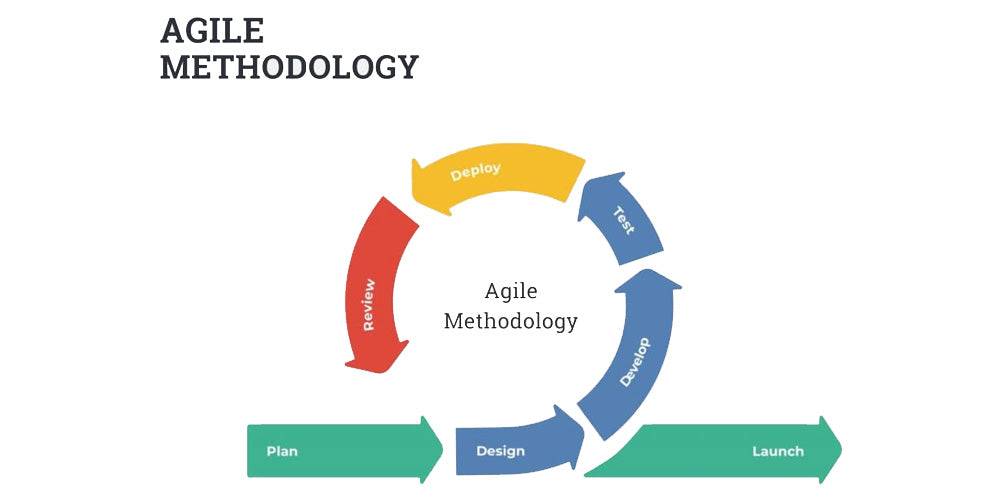
If you need clarification on why an agile approach is necessary for many organizations, we mention some attractive advantages they must consider below.
- Reduces procrastination.
- Improves the solution’s delivery time.
- Enhances flexibility and adaptability to new conditions.
- Increases the velocity when detecting issues or defects.
- Optimizes agile software development.
- Improve the general control over the processes.
- Enhance the relationship between team members.
- Improves the focus on the detection of customers' needs.
What Are the Differences Between Agile Planning and Traditional Planning?
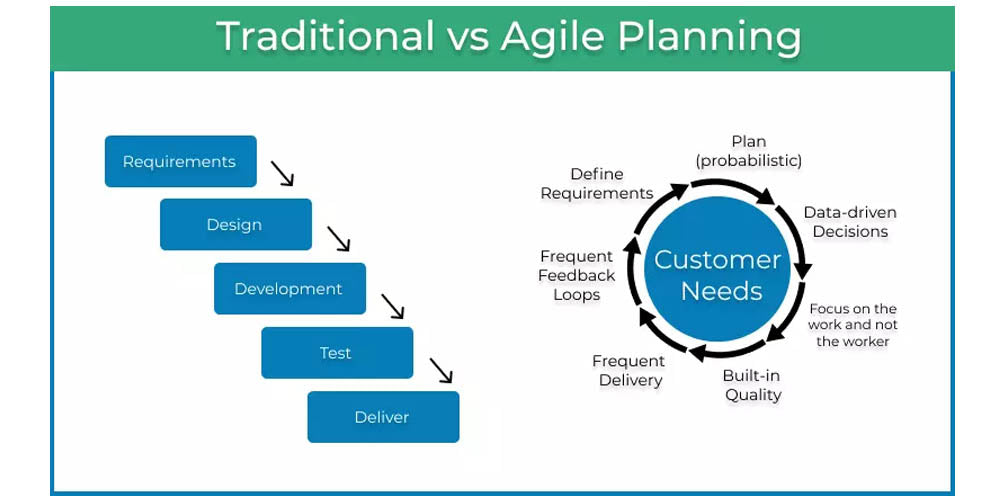
Source: Kanbanize.
Traditional project management, AKA the Waterfall process, involves a lot of effort from the first steps. In these types of planning, the project portfolio management tools are in charge of business leaders who spend a lot of time clarifying details for execution plans.
However, currently markets are faster and more dynamic. Businesses and projects require flexibility, willingness to change, and following market trends.
Nowadays, the new productivity process involves using heads more than hands and constant feedback from colleagues and other stakeholders.
The main difference between agile and traditional approaches is that the first approach uses iterations throughout the project, which is better for adapting to changes.
Besides, in agile methodologies, the self-organizing teams make decisions regarding using the right tools and report their advances.
Another critical difference between both approaches is that you lay down detailed plans for short iterations and one or two planning levels. An iteration starts, so you only should plan the highest priority for the next iteration.
How to Create Agile Project Planning? A Step-by-Step Guide
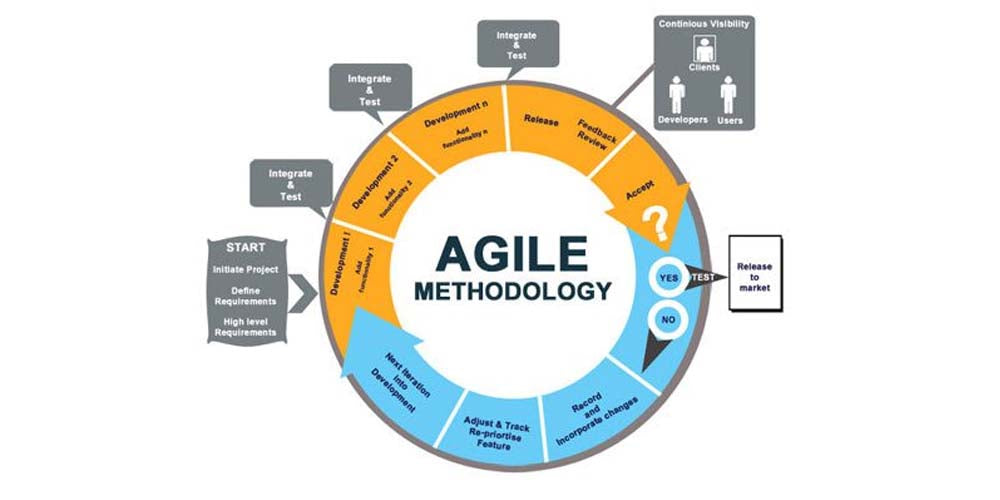
Carrying out agile project planning involves developing some specific steps. Now, we describe the six main stages you should remember to maintain an excellent agile methodology.
1. Preplanning
Before starting a project with an agile methodology, the organization's project manager should be capable of identifying a general scope, a business case, and the product roadmap.
The project execution starts with a preplanning phase where the teams collect all the required data, such as technical requirements, time, and cost estimation.
Technical requirements are called "product backlog," containing everything necessary to deliver a final product.
At this point, there are two types of backlogs you should consider:
- Product backlog. A list of all things that will be built into the product;
- Iteration backlog. A list of items that will be built during the current iteration.
Thanks to this, the development teams can estimate the time it takes to perform and release activities. Teams can also calculate the general project duration and the overall cost in a rough way.
2. Planning
Now you have a general perspective of how many resources the project will require, the cost, and the duration, it's time to plan the releases and iterations.
Here your organization can decide whether to release each iteration when it becomes available or release a collection of iterations rather than just one.
Besides, your team can plan right after finishing the product backlog or after completing the first iterations.
3. Release Planning
In this step, stakeholders break the functionality in the backlog into a certain number of iterations completed in the estimated time. They add iterations to releases. Besides, based on the release plan, they can identify the time for the release milestones.
One of the best practices to evaluate the needed time and plan estimates for an iteration is to check past features' delivery time.
For instance, if your team could deliver X number of features in previous software development projects for iteration, it's evident that it can provide X number of features in the current iteration.
Other good practices to estimate the length of milestones are the following:
- Be realistic, not optimistic;
- Consider historical data;
- Estimate the time of small specific tasks rather than larger ones.
Here the project team also evaluates the labor cost of the team and identifies iterations to calculate the overall project cost. Material costs also must be added to this number.
4. Iteration Planning
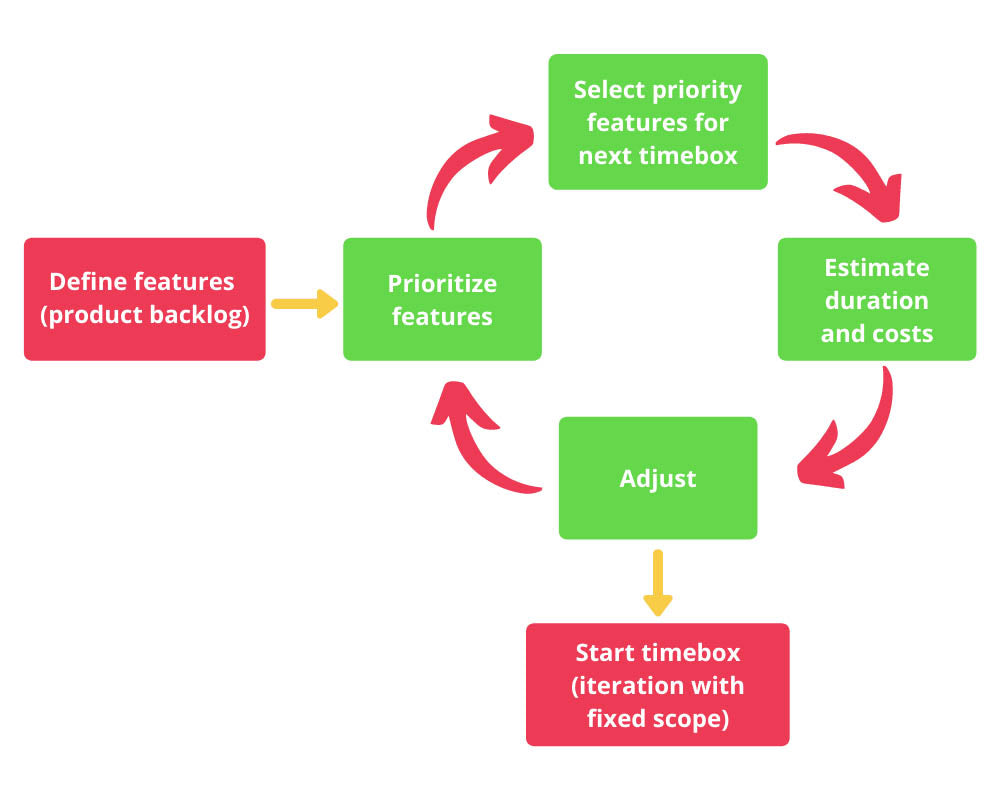
The iterative approach of agile planning implies planning the next iteration. To do this, the project team meets to identify the scope of the subsequent sprint.
In the first step of iteration planning, the team defines the features of the product backlog and their priority. Reprioritization could happen in subsequent phases.
After defining on detail features from the customer, the team picks the features from the backlog they believe can be accomplished in future iterations.
The agile manifesto says that the team must identify the user stories to help implement the chosen features. This way, you can assign task owners and estimate the duration of these tasks. You and your team can also discover if the effort involved in completing a specific feature is bigger or smaller than the estimated iteration time.
As a result, some features can be removed or added to the backlog. Then, with functionality advancing to the product backlog, you can reprioritize features.
5. Manage Product Backlog
Once your team finishes an iteration, you can recalculate the time to complete a project based on the customer's changes to the backlog. The scope is locked only in the current iteration!
The number of releases and iterations can also change as the backlog can change—the result of an iteration and the release planning influence each other.
If your team removes or adds features, the number of future iterations and the collection of iterations could change.
Finally, your team can summarize all these changes activities, i.e., modifying priorities, the scope, or the total project length in the "Manage Product Backlog."
6. Perform Daily Meetings
From the beginning of the same process, i.e., from every iteration, you should gather all the team to discuss key features, and every member should report their status in detail. Below you'll find the essential characteristics of daily standup meetings:
- They do not take over 15 minutes long. This duration should be a fixed length.
- It can also be a retrospective meeting to discuss a previous iteration and how team members achieve new results. In this sense, every member has only one minute to report their advances and accomplishments.
- The task status can be only labeled with "done" or "not done." If it's the second label, typically, the member should mention how many hours remain to finish the task. All the team should update time tracking to improve the team's velocity.
- Obstacles team members find through unit tests should be stated and discussed later in different stages.
- The scrum master is responsible for helping team members overcome obstacles by using new features and considering customer needs.
Agile Planning Templates
Now we give you some agile planning templates your project teams can download to use on a building software project and adopt agile approaches.
Agile Project Plan Template
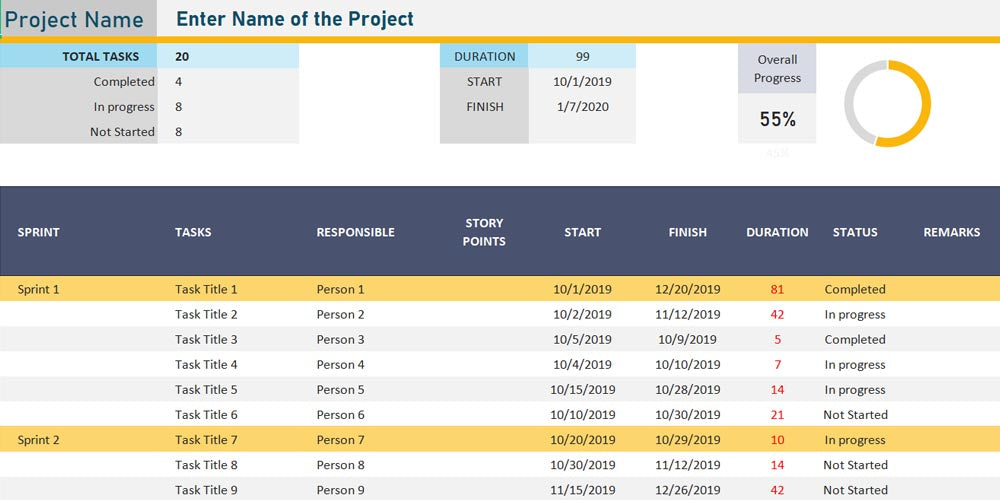
This file is a handy Microsoft Excel template that clearly defines and differentiates sprints/iterations and tasks in rows and articulates columns for owners, status, and more. Besides, it integrates a Gantt chart that clearly shows you when the tasks start and finish. Between each iteration, you can perform a sprint planning meeting to organize new cycles, check the team velocity, and perform other responsibilities.
You can download this agile project planning template from Projectplantemplate.
Second Agile Project Plan Template

This spreadsheet agile project plan template is very similar to the previous one. It considers three sprints and three features/tasks for each and incorporates columns for responsible, the start and end date, status, and even for comments. It also integrates a Gantt chart zone where you can track tasks throughout the time. It’s an excellent template for working software such as Excel.
You can download this spreadsheet agile project template from Smartsheet.
PowerPoint Agile Project Plan Template
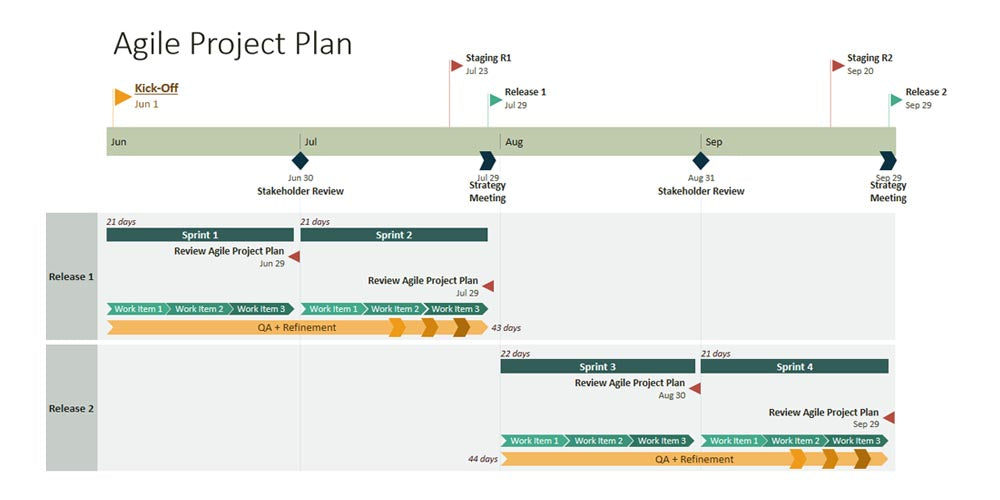
As you can read in the name of this template, this is a template for PowerPoint, so it has apparent differences from the abovementioned ones. It’s a Gantt chart template, a vast timeline, where you can insert and configure all the tasks you want, establish start and end dates and backlog items, and have a big picture of the project. The best of this template is it’s highly scalable and effortless to edit.
You can download this PowerPoint agile project plan template from Officetimeline.
Getting Microsoft Office to Edit Agile Planning Templates
The templates we give you above require Microsoft Office to work on them. As we know that getting the Office suite can be a bit expensive on the official Microsoft website, we’re here to offer you Office 2021 at a reasonable price. Get a reliable copy of a Microsoft Office 2021 Professional Plus Key Retail Global at €6,20.
Some Good Practices when Using Agile Methodologies
Some agile method guidelines are mandatory to perform agile scheduling to improve results and achieve estimated goals.
- Involve the entire team in iterative development. Scheduling and estimating are team activities, so every team member should be part of the process, even to promote buy-in.
- Schedule in detail only for the current or next iteration. Small intervals, or iterations, are perfect for managing uncertainty. If you schedule too far in advance (such as traditional methodologies), you won’t be able to respond to changes in features, priorities, and more.
- Design and testing are parts of the development process. Designing solutions and making test-driven development are fundamental activities during iterations and estimating schedules.
- Sprint planning meetings are an integral part of teamwork. Running an iteration planning meeting will help you to analyze the release plan and change priorities, features, and time of new iterations.
- Teamwork and collaboration are indispensable. Agile plans consider individual tasks and interactions, but teamwork and collaboration are two of the main principles. An agile work method considers a product owner and managers, but the team owns the plan and is responsible for project requirements and deadlines.
Bottom Line
New markets require velocity, faster data-driven decisions, implementation of the right tools to achieve better results, and participation of all stakeholders in the projects. Agile planning is crucial to reach a potentially shippable product increment and satisfy customer needs.
In agile methodology, all the members of your organization are on the same page, contributing to building an excellent software product, changing priorities, and paying particular attention to previous sprints and experience.
If you still need to try, we encourage you to implement this development to add the most value to your results.















